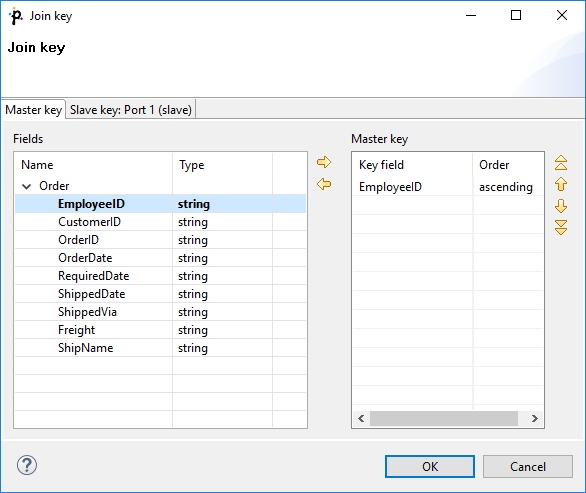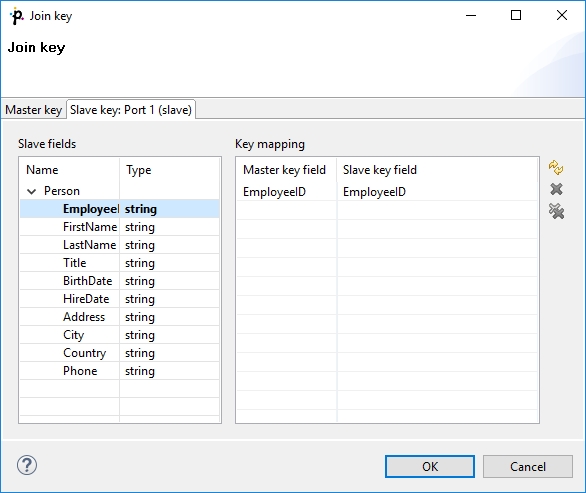ExtMergeJoin
Short Description
General purpose joiner that merges sorted data from two or more data sources on a common key.
ExtMergeJoin
x
✓
1-n
1-2
x
x
✓
✓
Ports
ExtMergeJoin receives data through two or more input ports, each of which may have a distinct metadata structure.
The joined data is then sent to the single output port.
Input
0
✓
Master input port
Any
1
✓
Slave input port
Any
2-n
x
Optional slave input ports
Any
Output
0
✓
Output port for the joined data
Any
1
x
Output port for the unjoined data
Input 0
Metadata
ExtMergeJoin propagates metadata from the first input port to the second output port and from the second output port to the first input port.
ExtMergeJoin has no metadata templates.
Metadata on the first input and the second output must be the same. (Metadata fields must have the same types, metadata field names may differ.)
ExtMergeJoin Attributes
BASIC
Join key
yes
A key according to which incoming data flows are joined. See Join Key below.
Join type
Type of the join. See Join Types below.
Inner (default) | Left outer | Full outer
Transform
[bl
A transformation in CTL or Java defined in a graph.
Transform URL
[bl
An external file defining the transformation in CTL or Java.
Transform class
[bl
External transformation class.
Transform source charset
Encoding of an external file defining the transformation. The default encoding depends on DEFAULT_SOURCE_CODE_CHARSET in defaultProperties.
E.g. UTF-8
ADVANCED
Allow slave duplicates
If set to true, records with duplicate key values are allowed. If it is false, only the last record is used for join.
true (default) | false
DEPRECATED
Locale
Locale to be used when internationalization is used.
Case sensitive
If set to true, upper and lower cases of characters are considered different. By default, they are processed as if they were equal to each other.
false (default) | true
Error actions
A definition of the action that should be performed when the specified transformation returns an Error code. See Return Values of Transformations.
Error log
An URL of the file to which error messages for specified Error actions should be written. If not set, they are written to Console.
Ascending ordering of inputs
If set to true, incoming records are supposed to be sorted in ascending order. If it is set to false, they are descending.
true (default) | false
Left outer
If set to true, left outer join is performed. By default, the attribute is set to false. However, this attribute has a lower priority than Join type. If you set both, only Join type will be applied.
false (default) | true
Full outer
If set to true, full outer join is performed. By default, the attribute is set to false. However, this attribute has a lower priority than Join type. If you set both, only Join type will be applied.
false (default) | true
[1] One of these must be set. These transformation attributes must be specified. Any of these transformation attributes must use a common CTL template for Joiners or implement a RecordTransforminterface.
For more information, see CTL Scripting Specifics or Java Interfaces below.
For detailed information about transformations, see also Defining Transformations.
Details
ExtMergeJoin is a general purpose joiner used in most common situations. It requires the input be sorted and is very fast as there is no caching (unlike ExtHashJoin).
The data attached to the first input port is called the master (as usual in other Joiners). All remaining connected input ports are called slaves. Each master record is matched to all slave records on one or more fields known as the join key. For a closer look on how data is merged, see Data Merging below.
Join Key
Join Key defines a key that is used to join the records. The Join key attribute is a sequence of individual key expressions for the master and all of the slaves. The parts corresponding to particular input ports are separated from each other by hash. The order of these expressions must correspond to the order of the input ports starting with the master and continuing with the slaves. Driver (master) key is a sequence of driver (master) field names (each of them should be preceded by a dollar sign) separated by a colon, semicolon or pipe. Each slave key is a sequence of slave field names (each of them should be preceded by a dollar sign) separated by a colon, semicolon or pipe; e.g.:
$field1(a);$field2(d)#$hello(a);$olleh(d)
The Join key string in the example above contains sorting characters (a) (ascending) and (d) (descending). For more details on sorting, see Sort Key.
You must define the Join key. Records on the input ports must be sorted according to the corresponding parts of the Join key attribute. You can define Join key in the Join key dialog.
In it, you can see the tab for the driver (the Master key tab) and the tabs for all of the slave input ports (the Slave key tabs).
Master Key Tab

In the driver tab, there are two panes. The Fields pane on the left and the Master key pane on the right.
You need to select the driver expression by selecting the fields in the Fields pane on the left and moving them to the Master key pane on the right with the help of the Right arrow button.
To the selected Master key fields, the same number of fields should be mapped within each slave. Thus, the number of key fields is the same for all input ports (both the master and each slave). In addition, the driver (Master) key must be common for all slaves.
Slave Key Tab

In each of the slave tab(s), there are two panes: Fields and Key mapping. The Fields pane is on the left. There you can see the list of the slave field names and their data types. The Key mapping pane is on the right. In the right pane you can see two columns: Master key field and Slave key field. The left column contains the selected field names of the driver input port.
If you want to map some driver field to some slave field, select the slave field in the left pane by clicking its item. Then push the left mouse button, drag the field to the Slave key field column in the right pane and release the button. The same must be done for each slave. Note that you can also use the Auto mapping button or other buttons in each tab.
Example 44. Join Key for ExtMergeJoin
$first_name;$last_name#$fname;$lname#$f_name;$l_nameFollowing is the part of Join key for the master data source (input port 0):
$first_name;$last_name
Thus, these fields are joined with the two fields from the first slave data source (input port 1):
$fnameand$lname, respectively.And, these fields are also joined with the two fields from the second slave data source (input port 2):
$f_nameand$l_name, respectively.
Data Merging Joining data in ExtMergeJoin works the following way. First of all, let us stress again that data on both the master and the slave have to be sorted.
The component takes the first record from the master and compares it to the first one from the slave (with respect to Join key). There are three possible comparison results:
master equals slave - records are joined
"slave.key < master.key" - the component looks onto the next slave record, i.e. a one-step shift is performed trying to get a matching slave to the current master
slave.key > master.key - the component looks onto the next master record, i.e. a regular one-step shift is performed on the master
Some input data contain sequences of same values. Then they are treated as one unit on the slave (a slave record knows the value of the following record), This happens only if Allow slave duplicates has been set to true. Moreover, the same-values unit gets stored in the memory. On the master, merging goes all the same by comparing one master record after another to the slave.
Transformation A transformation in ExtMergeJoin is required. Use one of the Transform, Transform URL and Transform class attributes to specify the transformation.
A transformation in ExtMergeJoin lets you define the transformation that sends records to the first output port. The unjoined master records sent to the second output cannot be modified within the ExtMergeJoin transformation.
CTL Scripting Specifics All Joiners share the same transformation template which can be found in CTL Templates for Joiners. For detailed information about Data Shaper Transformation Language, see CTL2 - Data Shaper Transformation Language.
Java Interfaces If you define your transformation in Java, it must implement the following interface that is common for all Joiners: Java Interfaces for Joiners.
Best Practices
If the transformation is specified in an external file (with Transform URL), we recommend users to explicitly specify Transform source charset.
See also
Common Properties of Components Specific Attribute Types Common Properties of Joiners
Last updated